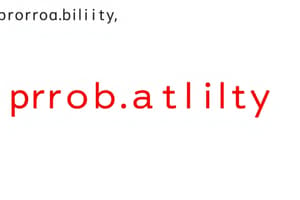Podcast
Questions and Answers
प्रायिकता (संभावना) क्या है?
प्रायिकता (संभावना) क्या है?
किसी घटना के घटित होने की सम्भावना को प्रायिकता कहते हैं।
प्रयोग (Trial) क्या है?
प्रयोग (Trial) क्या है?
कोई भी क्रिया जिसके परिणाम अपेक्षाकृत निश्चित हों, उसे प्रयोग कहते हैं।
घटना (Event) क्या है?
घटना (Event) क्या है?
किसी प्रयोग का कोई सम्भावित परिणाम, घटना कहलाता है।
प्रायिकता की गणना कैसे करते हैं?
प्रायिकता की गणना कैसे करते हैं?
प्रतिलोम घटना (Complementary Event) क्या हैं?
प्रतिलोम घटना (Complementary Event) क्या हैं?
किसी घटना की प्रायिकता 0 और 1 के बीच होती है।
किसी घटना की प्रायिकता 0 और 1 के बीच होती है।
सिक्के को उछालने पर चित या पट आने की प्रायिकता क्या है?
सिक्के को उछालने पर चित या पट आने की प्रायिकता क्या है?
किसी घटना की सभी प्रायिकताओं का योग कितना होता है?
किसी घटना की सभी प्रायिकताओं का योग कितना होता है?
पासे को फेंकने पर 4 से कम या 4 के बराबर संख्या प्राप्त करने की प्रायिकता क्या है?
पासे को फेंकने पर 4 से कम या 4 के बराबर संख्या प्राप्त करने की प्रायिकता क्या है?
यदि दो घटनाएं प्रतिलोम हैं, तो उनकी प्रायिकताओं का योग 1 होता है।
यदि दो घटनाएं प्रतिलोम हैं, तो उनकी प्रायिकताओं का योग 1 होता है।
Flashcards
परीक्षण (Trial)
परीक्षण (Trial)
कोई भी क्रिया जिसका परिणाम एक या अधिक परिणाम होता है।
घटना की प्रायिकता (Probability of an Event)
घटना की प्रायिकता (Probability of an Event)
किसी घटना के घटित होने की संभावना, कुल परीक्षणों की संख्या से संबंधित।
अनुभवजन्य प्रायिकता (Empirical Probability)
अनुभवजन्य प्रायिकता (Empirical Probability)
विभिन्न परीक्षणों के परिणामों के आधार पर निकाली गई प्रायिकता।
प्रायिकता की सीमा (Range of Probability)
प्रायिकता की सीमा (Range of Probability)
Signup and view all the flashcards
सभी प्रायिकताओं का योग
सभी प्रायिकताओं का योग
Signup and view all the flashcards
सिक्के के उछाल के परिणाम
सिक्के के उछाल के परिणाम
Signup and view all the flashcards
पासे के फेंकने के परिणाम
पासे के फेंकने के परिणाम
Signup and view all the flashcards
समान संभावना (Equally Likely Outcomes)
समान संभावना (Equally Likely Outcomes)
Signup and view all the flashcards
पूरक घटनाएं (Complementary Events)
पूरक घटनाएं (Complementary Events)
Signup and view all the flashcards
किसी घटना के लिए अनुकूल परिणामों की संख्या
किसी घटना के लिए अनुकूल परिणामों की संख्या
Signup and view all the flashcards
Study Notes
Probability (संभावना)
- A trial is an action resulting in one or more outcomes.
- Each toss of a coin, or a roll of a dice is an example of a trial
- All possible outcomes for tossing a coin are head or tail (2).
- All possible outcomes for rolling a dice are 1, 2, 3, 4, 5, and 6 (6).
Trial (परीक्षण)
- A trial is an action.
- Examples include tossing a coin or rolling a dice.
Probability of an Event (किसी घटना की प्रायिकता)
- The empirical probability of an event is the number of trials in which the event happened divided by the total number of trials.
- Probability (P(E)) = (Number of trials in which the event happened) / (Total number of trials)
- The probability of any event lies between 0 and 1.
- Sum of probabilities of all possible outcomes is 1.
Complementary Events (पूरक घटनाएँ)
- Complementary events are two events such that if one happens the other cannot.
- The probabilities of complementary events add up to 1.
- Example: if event E is the chance of a number greater than 4 being rolled, then the complementary event (not-E or F) is the chance of rolling a number less than or equal to 4.
- P(E) + P(not E) = 1
Studying That Suits You
Use AI to generate personalized quizzes and flashcards to suit your learning preferences.




